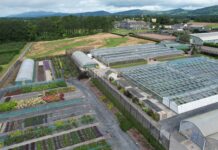

A major report: “Carbon Neutrality as a ‘horizon point’ for Irish agriculture: a qualitative appraisal of potential pathways to 2050”. In this report, Teagasc assesses how Irish agriculture can approach carbon-neutrality by 2050.
Addressing climate change across the economy is now a major policy concern for government, with carbon neutrality being considered as a target for the agriculture sector. Carbon-neutrality would require Irish agriculture to lock away as much greenhouse gases as it emits, resulting in so called ‘zero net emissions’ from the agricultural sector. In practical terms this means that agricultural greenhouse gas emissions (methane, nitrous oxide and carbon dioxide) generated by agriculture would have to be offset by carbon sequestration and the displacement of fossil fuels emissions by the sector. ‘Carbon-neutrality’ has been proposed as a “horizon point for agriculture by 2050” by the Secretariat of the National Economic and Social Council and by the Oireachtas Committee on Environment, Culture and the Gaeltacht.
The Teagasc report finds that in absence of a comprehensive strategy for ‘carbon-neutrality’, it is likely that only a small part of agricultural greenhouse gas emissions will be offset by carbon-sequestration in grasslands and forestry in the coming decades, thus leaving an ‘emissions gap’. However, on an optimistic note the report finds that there are options that could be utilised to narrow, if not close, this emissions gap between now and 2050.
The report assesses the feasibility of five potential approaches to address the emissions gap: 1) an acceleration of forestry planting rates to increase carbon sequestration; 2) the use of advanced technologies and mitigation strategies to reduce emissions; 3) a dramatic increase in the cultivation of bioenergy crops (including anaerobic digestion of grass) to offset fossil fuel emissions; 4) constraining agricultural activity to limit emissions and 5) an acceptance that agriculture emissions will need to increase to some extent to satisfy growing future food demand.
The report concludes that partial carbon-neutrality for agriculture may be achieved by 2050 by the selective implementation of all five pathways simultaneously. However, the report emphasises that immediate action is needed in order to set a course towards carbon-neutrality by 2050.
Director of Research in Teagasc, Dr Frank O’Mara explained: “Teagasc welcomes the concept of carbon-neutrality, as it significantly broadens the menu of options open to farmers to contribute constructively to reducing net emissions from agriculture, while at the same time growing the production and export of food.” Dr O’Mara added that carbon-neutrality should be seen as a ‘horizon point’ for the agricultural sector to aim for, rather than a target, as full carbon-neutrality may not be technically feasible.
At the launch of the report, Teagasc Director Prof Gerry Boyle highlighted the effective collaboration between Teagasc, government departments and state agencies in preparing a low-carbon vision for agriculture: “For this report Teagasc was able to draw on the constructive ideas and input from our colleagues in the Department of Agriculture, Food and the Marine, the Department of Environment, Community and Local Government, the Secretariat of the National Economic and Social Council, as well as the Environmental Protection Agency.”
The study was conducted in the context of the development of a new national climate change policy and the publication of the Heads of a Climate Action and Low-Carbon Development Bill on 26 February 2013 by the Minister for the Environment, Community and Local Government, Minister Phil Hogan, T.D.








